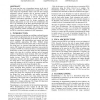Free Online Productivity Tools
i2Speak
i2Symbol
i2OCR
iTex2Img
iWeb2Print
iWeb2Shot
i2Type
iPdf2Split
iPdf2Merge
i2Bopomofo
i2Arabic
i2Style
i2Image
i2PDF
iLatex2Rtf
Sci2ools
ICCAD
2003
IEEE
2003
IEEE
Multi-Million Gate FPGA Physical Design Challenges
The recent past has seen a tremendous increase in the size of design circuits that can be implemented in a single FPGA. These large design sizes significantly impact cycle time due to design automation software runtimes and an increased number of performance based iterations. New FPGA physical design approaches need to be utilized to alleviate some of these problems. Hierarchical approaches to divide and conquer the design, early estimation tools for design exploration, and physical optimizations are some of the key methodologies that have to be introduced in the FPGA physical design tools. This paper will investigate the loss/benefit in quality of results due to hierarchical approaches and compare and contrast some of the design automation problem formulations and solutions needed for FPGAs versus known standard cell ASIC approaches.
| Added | 16 Mar 2010 |
| Updated | 16 Mar 2010 |
| Type | Conference |
| Year | 2003 |
| Where | ICCAD |
| Authors | Maogang Wang, Abhishek Ranjan, Salil Raje |
Comments (0)

